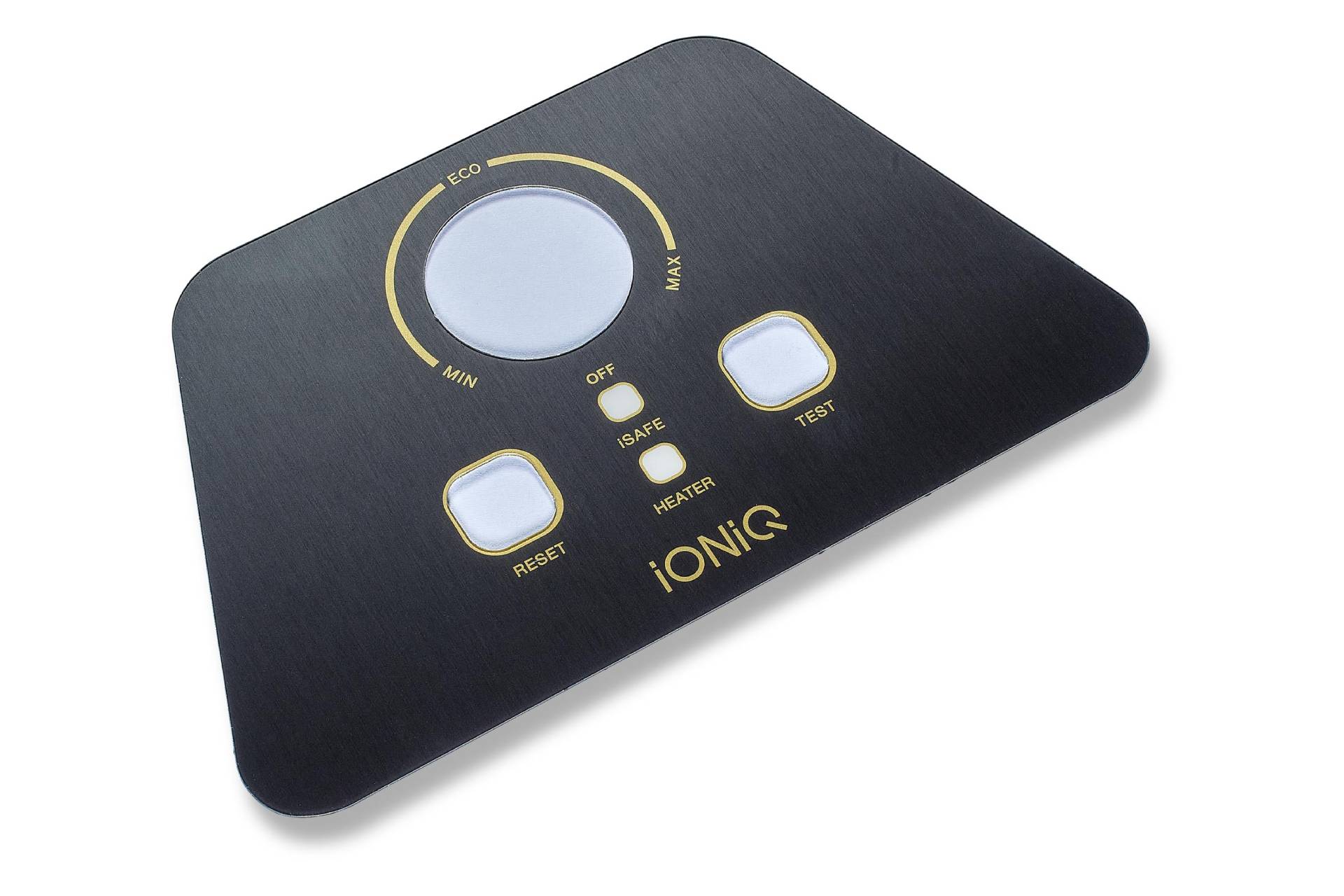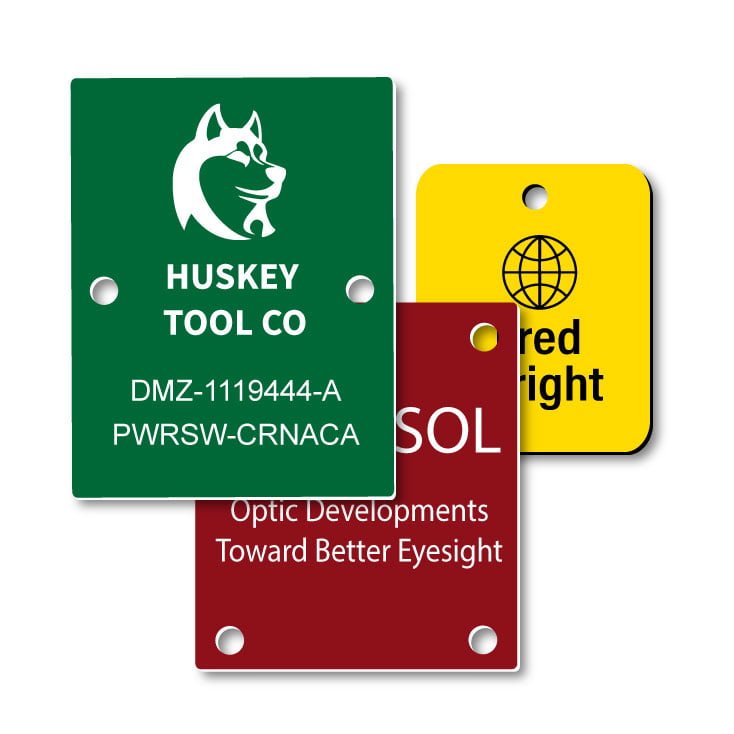How to Design Eye-Catching Plastic Nameplates for Your Brand
Comprehending How Plastic Nameplates Job: Insights Into Their Functionality and Advantages
Plastic nameplates are necessary devices for identification and interaction in various environments. Constructed from sturdy products like acrylic and PVC, they provide both resilience and aesthetic allure. Various printing techniques boost their exposure and branding potential. Recognizing their functionality exposes not just their practical applications however also the advantages they give organizations. As industries develop, the function of plastic nameplates might move, motivating a closer look at their recurring relevance and advancement.
The Products Behind Plastic Nameplates
Plastic nameplates are crafted from a variety of products, each picked for its unique homes and viability for different applications. Usual materials include acrylic, polycarbonate, and PVC, each offering unique advantages. Polymer is preferred for its quality and light-weight nature, making it excellent for indoor use and screen objectives. Polycarbonate, recognized for its high influence resistance, is frequently picked for environments where sturdiness is necessary (Plastic Nameplates). PVC, on the various other hand, supplies a cost-efficient remedy with suitable weather resistance, ideal for exterior applications.Additionally, the selection of material can influence aspects such as color retention, convenience of printing, and overall aesthetic charm. This selection process guarantees that the last item satisfies particular requirements, whether for branding, identification, or attractive functions. Understanding the residential properties of these products assists in making informed decisions when selecting plastic nameplates for numerous needs
Manufacturing Processes of Plastic Nameplates
The manufacturing processes of plastic nameplates incorporate numerous critical steps that assure high quality and toughness. Trick facets include material selection methods, different printing techniques, and finishing and coating choices. Comprehending these elements is essential for generating efficient and aesthetically pleasing nameplates.
Product Choice Techniques
Selecting the right products for manufacturing plastic nameplates is crucial for making certain longevity, aesthetic allure, and capability. Numerous plastic types are available, each offering special buildings suited for various applications. Polyvinyl chloride (PVC) is preferred for its price and resistance to ecological aspects, making it optimal for exterior use. Acrylonitrile butadiene styrene (ABDOMINAL MUSCLE) offers boosted impact resistance and is commonly chosen for its superior toughness and adaptability. Furthermore, polycarbonate is favored for applications calling for transparency and high effect resistance. The selection procedure includes thinking about factors such as the planned use, ecological exposure, and preferred aesthetic qualities. Eventually, cautious product selection substantially influences the performance and durability of plastic nameplates, satisfying varied industry demands.
Printing Techniques Review
Product option lays the foundation for the subsequent printing methods utilized in creating plastic nameplates. Different methods, such as screen printing, digital printing, and pad printing, are used to attain long lasting coatings and top quality styles. Screen printing is favored for its ability to produce vibrant colors and is appropriate for large runs. Digital printing, on the other hand, offers flexibility and precision, making it excellent for smaller sized orders with detailed styles or variable data. Pad printing enables the transfer of images onto irregular surface areas, suiting intricate shapes. Each printing method adds distinctly to the final product's look and durability, making sure that the nameplates successfully share the intended message and stand up to ecological factors.
Finishing and Covering Options
Ending up and finish choices play a necessary role in enhancing the sturdiness and aesthetic charm of plastic nameplates. Different strategies, such as UV layer, supply a protective layer that withstands scratches and fading, substantially prolonging the product's life-span. Furthermore, laminating flooring choices can provide a matte or shiny finish, enabling for customization to match branding demands. Plating and electroplating are likewise popular methods, adding a metal sheen while boosting corrosion resistance. These layers not only boost appearance however additionally add to the nameplate's performance by safeguarding against ecological factors. Moreover, specialized surfaces, such as anti-graffiti finishes, guarantee that nameplates preserve their clarity and aesthetic allure in tough problems. The right finishing and coating options can greatly enhance the total value of plastic nameplates.
Layout Options for Customization
While discovering design choices for customization, one discovers a broad variety of opportunities that can boost the practical and aesthetic charm of plastic nameplates. Color choice is a main consideration, as lively shades can draw in focus while neutral tones promote professionalism. Various font style options and sizes furthermore customize nameplates, making sure clarity and placement with brand name identity.Incorporating logos or images includes a distinct touch, strengthening business branding. Moreover, form modification permits for distinct layouts, ranging from conventional rectangles to more detailed kinds, accommodating particular themes or environments.Textures such as matte or shiny surfaces can also affect the total appearance, providing a responsive dimension. Furthermore, the combination of attractive components like backgrounds or boundaries enhances visual rate of interest. These personalization options collectively make it possible for organizations to create plastic nameplates that properly communicate their identification and message while satisfying useful demands.

Sturdiness and Long Life of Plastic Nameplates
Several aspects affect the toughness of plastic nameplates, the choice of material and production processes plays a significant function in their durability. High-quality plastics, such as polycarbonate and acrylic, are usually chosen for their inherent resistance to effect, weather condition, and UV radiation. These materials can hold up against severe ecological conditions without considerable degradation, ensuring that nameplates continue to be intact over time.Furthermore, advanced production strategies, such as shot molding and laser engraving, add to the effectiveness of plastic nameplates. These processes produce accurate and durable inscriptions that resist fading and wear. In addition, safety finishings might be related to enhance resistance to scratches and chemicals, additionally expanding their lifespan.Ultimately, the combination of quality materials and reliable production processes guarantees that plastic nameplates preserve their capability and look for many years, making them a dependable option for different applications.
Applications Throughout Different Industries
Plastic nameplates serve a variety of important features across different industries. They are generally utilized for industrial devices recognition, guaranteeing clear labeling for security and operational effectiveness. In addition, they supply reliable workplace signage solutions and play an important duty in safety and security and conformity markings, highlighting their flexibility and value in diverse environments.
Industrial Equipment Identification
Efficient commercial devices recognition is important across various industries, as it ensures safety, efficiency, and conformity with regulative requirements. Plastic nameplates function as a vital device in this process, offering long lasting and clear identification for machinery and devices. Industries such as construction, manufacturing, and energy use these nameplates to display Homepage crucial details, including running directions, hazard warnings, and upkeep schedules. Their strength to extreme settings guarantees that essential information remains obtainable, lowering the danger of mishaps and functional downtime. Furthermore, customizable attributes allow for branding and details labeling demands, making plastic their explanation nameplates functional throughout applications. Generally, efficient tools recognition with plastic nameplates fosters a much safer office while improving productivity in diverse industrial setups.
Workplace Signage Solutions

In different sectors, the importance of clear communication prolongs beyond industrial devices to office settings where signs plays a crucial role. Plastic nameplates work as effective workplace signage solutions, offering necessary details such as worker names, job titles, and department classifications. These nameplates boost professionalism and foster a welcoming atmosphere, aiding both staff and visitors in navigating the office. In addition, they use modification alternatives, allowing organizations to align signs with branding and aesthetic choices. In settings like healthcare facilities, academic organizations, and business workplaces, long lasting and clear signage guarantees effective interaction and adds to business effectiveness. Inevitably, using plastic nameplates in office environments not just boosts quality but likewise advertises a cohesive and organized office.
Security and Compliance Markings
While several organizations focus on aesthetics and branding in their signs, security and compliance markings are similarly vital throughout various industries. These markings act as critical devices for interaction, assuring that staff members and consumers recognize potential hazards, security protocols, and regulative needs. In production, for circumstances, plastic nameplates typically display cautioning tags and use instructions to minimize risks. In health care, conformity signs notifies employees about hygiene methods and tools use, thus promoting a secure setting. Additionally, the sturdiness of plastic nameplates makes them ideal for numerous setups, withstanding damage from ecological elements. On the whole, security and conformity markings enhance operational efficiency, advertise health, and guarantee adherence to industry standards, making them indispensable in modern offices.
Benefits of Using Plastic Nameplates
Many benefits make plastic nameplates an appealing choice for companies and organizations. One primary benefit is their resilience; plastic nameplates are immune to fading, dampness, and numerous ecological variables, ensuring longevity in varied settings. In addition, they special info are lightweight, making them simple to set up and transfer as needed.Cost-effectiveness is another considerable benefit. Plastic nameplates typically call for reduced production costs contrasted to steel or timber alternatives, permitting organizations to preserve budgets while accomplishing professional branding. Their flexibility additionally sticks out, as they can be personalized in different shapes, dimensions, and colors to match branding requirements.Furthermore, plastic nameplates can be quickly printed with high-resolution designs, advertising clear exposure and reliable interaction. Finally, they are often made from recyclable products, straightening with environmentally mindful techniques. These combined benefits enhance the functionality and appeal of plastic nameplates for a variety of applications in different markets.

Tips for Selecting the Right Nameplate for Your Needs
Selecting the appropriate nameplate can greatly boost a company's branding and communication efforts. To make a notified decision, one must first take into consideration the material. Plastic nameplates use resilience and flexibility, making them perfect for different atmospheres. Next, evaluate the layout elements, consisting of size, shade, and font style, ensuring they align with the company's branding guidelines.Additionally, it is vital to analyze the designated use the nameplate. For example, if it requires to hold up against outside conditions, selecting UV-resistant alternatives is recommended. Modification is one more important factor; personalized nameplates can show originality and professionalism.Lastly, spending plan considerations must not be neglected. Comparing costs across various distributors while considering high quality will assist in finding an appropriate option. By taking these aspects into account, organizations can select a nameplate that efficiently communicates their identity and purpose.
Frequently Asked Questions
Can Plastic Nameplates Be Recycled After Use?
Plastic nameplates can be reused, relying on the kind of plastic used and neighborhood reusing centers. Correct disposal and recycling practices contribute to environmental sustainability, motivating the decrease of plastic waste in garbage dumps.
How Do I Clean and Preserve My Plastic Nameplate?

Are Plastic Nameplates Waterproof or Water-Resistant?
Plastic nameplates normally show waterproof residential or commercial properties, protecting them from minor dampness exposure. Extended submersion or harsh problems might compromise their integrity. Individuals need to take into consideration details materials and layers for enhanced water-proof capabilities when choosing nameplates
What Is the Average Life Expectancy of a Plastic Nameplate?
The typical lifespan of a plastic nameplate typically varies from five to 10 years, depending upon aspects such as environmental exposure, worldly top quality, and maintenance. Routine care can expand its functionality and look considerably.
Can I Order a Nameplate in a Details Shape?
Customized shape choices for nameplates are often available through numerous producers. Customers can ask for details designs, guaranteeing that the nameplate meets their practical and visual demands while preserving durability and top quality throughout its lifespan. Material option lays the groundwork for the succeeding printing techniques made use of in creating plastic nameplates. Many factors affect the sturdiness of plastic nameplates, the option of product and manufacturing procedures plays a significant role in their long life. These materials can stand up to severe ecological problems without significant degradation, ensuring that nameplates continue to be intact over time.Furthermore, progressed production techniques, such as injection molding and laser engraving, add to the effectiveness of plastic nameplates. Plastic nameplates can be recycled, depending on the type of plastic made use of and regional reusing centers. The average life expectancy of a plastic nameplate commonly varies from five to ten years, depending on aspects such as environmental direct exposure, material quality, and maintenance.